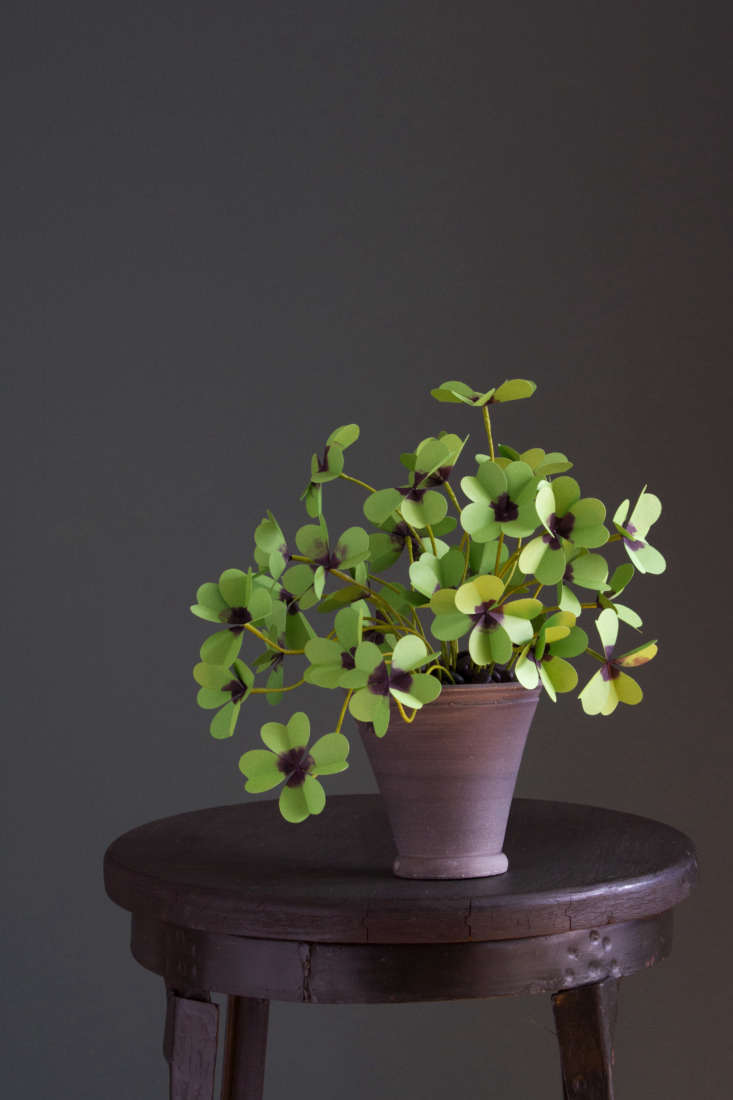Paper plants are having a moment, and no wonder. They are fanciful, three-dimensional versions of houseplants. In some cases better versions—they don’t die, the foliage never fades, and you don’t need to hire a sitter to water them when you go away.
Paper plant sculptures may awaken your inner crafter. Certainly the sight of a hand-painted paper geranium in artist Livia Cetti’s Bronx home or a six-foot-tall paper fiddle-leaf fig tree in Brooklyn-based artist Corrie Beth Hogg’s living room gets my X-Acto knife fingers twitching every time. With some colored paper, florists’ wire, and a green gel pen, could you or I make our own adorable paper pilea plants?
“Absolutely,” says Hogg, whose brand-new book Handmade Houseplants: Remarkably Realistic Plants You Can Make with Paper offers step-by-step instructions for 30 paper plant sculptures. “I’ve taught a couple of classes and it’s fun to see people walk away at the end having made such beautiful plants.”
To celebrate the book’s publication by Timber Press this week, Hogg has created 10 one-of-a-kind potted paper plant sculptures—which will go on sale at Brooklyn garden shop GRDN on September 13, at prices that range from $125 to $650, depending on size. Here are a few of our favorites:
Photography by Corrie Beth Hogg, except where noted.
Epimedium

“I wouldn’t want to be one of those artists who makes the same thing day after day,” says Hogg.
For DIYers, the time commitment to make a paper plant will vary, from a paper oxalis that requires only two or three hours’ effort (“with just three or five stems, it’s something sweet to put on a bedside table,” she says) to a fiddle-leaf fig tree, which can take a full weekend to fashion (you’ll be “paper maché-ing and painting and drilling” for that one).

What’s the first step to making a paper plant? Photographing a real plant. “I walk around and take pictures with my phone, including close-ups of leaves, and I also really try to understand the color of a plant,” Hogg says.
Oxalis

When it comes to choosing paper to make foliage, Hogg picks colors that are realistic. “But I’m not like a realism painter. I’m trying to imply color, in such a way that it doesn’t look too labored over, with minimal strokes.”

After growing up in the South, Hogg studied painting and photography at Memphis College of Art in the 1990s before coming to New York City. As the art-and-craft director for designer David Stark, her job description includes styling photographs (as well as shooting them), arranging florals, and creating craft and art projects from scratch.
“It’s a great job and by necessity, it has made me tap into into every craft skill I have ever cultivated,” she says.
The first paper plant she made was a six-foot-tall fiddle-leaf fig tree. “It all started when fiddle-leaf fig trees were at the height of their popularity and I wanted one, but my Brooklyn apartment windows were on one side only, so I couldn’t grow one,” she said. “I decided to make a glorious one out of paper. Four years later, it’s still going strong.”
Pilea

What supplies do you need to get started to make a paper plant? Wire cutters are a staple, says Hogg, who also frequently uses dark green alcohol markers and bright green gel pens to add emphasis and texture to foliage. She uses regular old paper because it’s easier to fold and shape than card stock. “I get really excited if I hear there’s a new glue or a new paint that came out, and then I have to try it,” she says.

How long will a paper plant last? “It’s pretty permanent, but it’s not going to last as long as a plastic plant,” says Hogg. “I’m sure it does have a life span. If it was sitting next to a window, the paper could potentially get bleached but i haven’t noticed any major decline in sculptures I’ve made so far.”
Begonia




Eager to start crafting? See more:
- Required Reading: The Exquisite Book of Paper Flowers by Livia Cetti
- Required Reading: The Fine Art of Paper Flowers













Have a Question or Comment About This Post?
Join the conversation